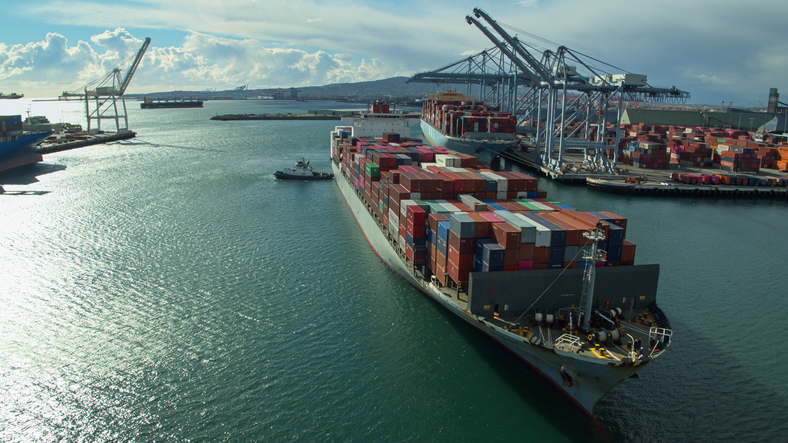America’s Ports Need Modernizing: The PIDP’s Impact and Outlook

The vision of the long line of container ships waiting to unload at the Ports of Los Angeles and Long Beach is hard to forget. Those West Coast ports experienced a backlog that reached a high of 109 container ships in January 2022. Lead times skyrocketed. Goods were delayed — to manufacturers, retailers and consumers.
Port congestion has eased, but there still are issues. America’s ports need modernization, U.S. maritime administrator Ann Phillips has said. “Modernizing the nation’s port infrastructure is vital to the reinforcement of America’s multimodal system for transporting goods,” she said in a U.S. Department of Transportation press release. “The advantages of cargo movement on water extend well beyond the maritime domain.”
In November, President Joe Biden announced the Port Infrastructure Development Program (PIDP), allocating more than US$653 million to fund 41 port improvement projects across the U.S. The PIDP, part of the Infrastructure Investment and Jobs Act of 2021, targets capacity expansion and faster movement of goods and includes $32 million for the reconstruction of a berth at Port Newark and $52.6 million for the North Harbor Transportation System Improvement Project at Long Beach, California.
“President Biden’s program is aimed at bolstering the U.S. supply chain reliability and reducing the prices of goods by addressing supply chain inefficiencies,” says Pawan Joshi, executive vice president of products and strategy at e2open, a supply chain software provider.
“Ocean shipping is one of the cheapest and lowest carbon impact (per ton per mile) mode of global transportation. It is key not just for the U.S., but for the global economy. This initiative focuses on improving the operating infrastructure at the ports, which will have an impact on improving supply chain efficiency, cutting shipping costs and improving overall reliability. The investment is expected to yield cost savings that will benefit consumers.”
The program underscores a holistic strategy to enhance competitiveness and establish a more robust supply chain, ultimately leading to sustained lower prices for goods in the U.S. market.
Joshi discusses other implications of the ports program as well as the outlook for U.S. ports this year.
Question: What impacts will the investment have on reducing strikes and other port challenges?
Answer: Improving the operating infrastructure at American ports with the modern equipment and technology will allow ports and terminals to be easier to operate and will provide a better working environment. The modern infrastructure adheres to the latest safety standards and tends to automate mundane, repeatable work creating safer and better working conditions. In addition, these also tend to be a lot eco-friendlier and have the potential to reducing environmental impact of daily port operations which involve the use of diesel-powered machinery and ships, contributing to air pollution and greenhouse gas emissions.
Capabilities like remote operations and monitoring, as well as use of electronic documents instead of paperwork, can further streamline operations and reduce congestion and backlogs. These improvements will all trickle down to creating a healthier and more sustainable environment, increasing labor productivity and mitigating the likelihood of strikes and unrest among port workers.
Q: In general, container ship backups at U.S. ports have eased. Discuss why.
A: This decrease can be credited to (1) the post-COVID-19 recovery, (2) seasonal changes in demand, (3) notable enhancements in infrastructure and (4) decreased global macroeconomic pressures. The alleviation of pandemic-related disruptions, along with heightened investments and streamlined operations, has collaboratively contributed to improvements, albeit small, in the global shipping environment.
In the last few years, there has also been an increase in the capacity of new ships across a large number of ocean carriers. This additional capacity has also contributed to improved sailing schedules and overall better availability of shipping capacity. Lastly, amid global and regional economic headwinds, port volumes across the U.S. Gulf, east coasts and northern Canada have seen a decline in volumes. Specifically, 2023 import volumes dropped by 22.2 percent across the key U.S. maritime ports.
Q: What are the complexities of the port supply chain? What is the importance of enhanced visibility to achieve optimal efficiency?
A: Ports are complex systems involving various processes and stakeholders. Attaining peak efficiency necessitates improving visibility, the real-time tracking of goods and information. This visibility is pivotal for well-informed decision-making, issue resolution and seamless coordination among businesses. It enables the timely identification and resolution of bottlenecks, ensuring a smooth flow of goods through ports and other modes within the supply chain.
In the modern business world, change is happening at a faster pace than ever. Cultural and political volatility, expanding markets and globalization have created an environment that can be wildly unpredictable. In this new reality, we need targeted technology to help businesses deliver their promises to their customers.
Q: What is the outlook for the rest of 2024?
A: The outlook for U.S. ports and container shipping this year remains robust, given strong consumer demand and ecommerce growth. However, there are some ongoing challenges such as congestion in the Panama Canal and labor shortages that will require collaborative efforts, technological innovation and sustainable practices to ensure the resilience and competitiveness of U.S. ports in the global shipping sector.
Overall, investing in advanced, eco-friendly technology for American ports promises to enhance working conditions, bolster safety, optimize efficiency and mitigate challenges like overcrowding. Moreover, it can reduce emissions, improve air quality, and ensure compliance with environmental regulations, fostering a more sustainable and efficient industry for the future.


